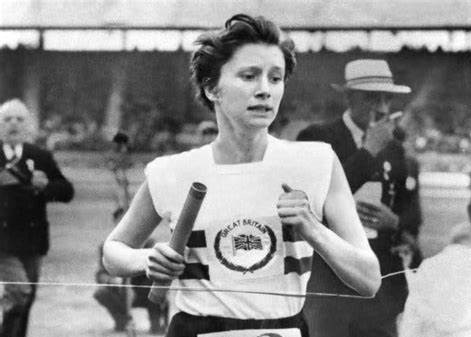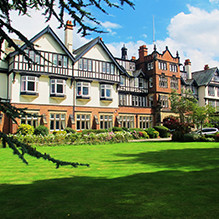Alumna was the first woman to run a sub 5-minute mile
Diane Leather attracted headlines around the world when she made history at the women’s athletics championships in Birmingham on May 29 1954. Now her former school, Harrogate Ladies’ College, plans to establish an award for promising female runners in recognition of her extraordinary feat. Diane’s achievement came just 23 days after Roger Bannister’s sub-four-minute mile, but with only a fraction of the acclaim, because of the low regard in which athletics held women’s distance running at the time.
Now the Principal of the College Mrs Sylvia Brett hopes Diane’s achievement will inspire keen runners at the school. She said:
“Diane was a pioneer and an amazing athlete. We’re determined her legacy for female athletes won’t be forgotten, and we hope the new award will help others achieve their dreams.”
The school intends to establish the award for athletes as part of its annual Speech Day.
While at school, Diane enjoyed all sports, particularly netball and lacrosse, but it was her running ability which marked her out from a young age. She had already come close to beating the five-minute mark on a number of occasions, and the quest to be first was hotly contested. In the previous year, Anne Oliver of Britain had run a record time of 5min 8sec, later bettered by Edith Treybal of Romania with 5min 3sec. On 26 May 1954, at the Alexander Sports Ground in Birmingham, Leather beat Treybal’s best with 5min 0.2sec. Three days later she tried again and this time she made history. Earlier in the afternoon she had competed in the 800m, but it was her mile race that really attracted the attention. Unlike Bannister’s historical marker, Leather’s was a genuine race, without pacemakers, and she led from start to finish. After a final surge in the last 100m she crossed the line in 4min 59.6sec. On being told her time, she said: “Oh good, at last!”

Diane Leather, breaking another world record
Her husband, Peter Charles, wrote later:
“It’s a sad fact that while Bannister’s story is known to all, Diane Leather is almost unheard of amongst the younger generations and outside of athletics circles.”
This was due to attitudes at the time towards women’s sport. Throughout the 20th century, there was a great deal of anxiety around women competing in various events: because of unfounded medical concerns, they were banned from the Olympic marathon until 1984 and only began ski jumping at the Winter Olympics in 2014. After Diane’s record run, it was another 13 years before the International Amateur Athletics Federation recognised women’s world records for the mile, and women were able to compete at the distance in international events – all of which came too late for her. Thankfully, recognition did come about in her later years. In the 2008 edition of Athletics Weekly, Leather was ranked No 2 in a list of all-time great 1500m runners, behind the double Olympic champion Kelly Holmes. More recently, in a BBC broadcast of the Great North Run two days after her death, Mo Farah, Kathrine Switzer and Laura Muir all paid tribute to Leather’s achievements. “I had no idea that I would ever be called a pioneer,” Leather said in 2014, on the 60th anniversary of her big race. But a pioneer she certainly was.
She was born in Streetly, Staffordshire, one of six children, and the only daughter, of James Leather, a surgeon, and his wife, Mabel (nee Barringer), and after her time as a boarder at the Ladies’ College she went on to Birmingham College of Technology (now Aston University) to train as a chemist. Watching the 1952 Olympic Games in Helsinki was to change her life, as Leather was inspired to join her local athletics club, Birchfield Harriers. There she discovered a natural talent for running, notching up a team world record for the 3 x 880yd relay, as well as a British record in the mile, in her first year at the club. Leather set a women’s “best”, as it was called, in 1953 for the mile, which she ran in 5min 2.6sec. Her historic 4min 59.6sec came the following year. Further records ensued, with 4min 50.8sec and 4min 45sec in 1955 – in total she held claim for eight years.
Her versatility across distances was notable. She won the 800m world record by running 2min 9sec in 1955, and gained a silver medal at the European Championships in 1954 and 1958 over the same distance. She also held the British 1500m record for 11 years. Additionally she won national and international cross-country titles.
In 1959 Leather married Peter Charles, an engineer – they had met as students. She competed at the 1960 Rome Olympic Games as Diane Charles, running in a preliminary heat in the 800m. Later that year she retired from competitive running, aged 27, and in 1961 gave birth to her first child. She studied for a diploma in social work, worked with the Hertfordshire child protection team and volunteered for the Samaritans, alongside raising four children and taking in foster children. In the early 1980s the family moved to Cornwall, where she worked for Cornwall child protection and volunteered at the charity Cruse Bereavement Care. Peter died in 2017. She is survived by their three sons, Matthew, Hamish and Rufus, and daughter, Lindsey, 13 grandchildren and three brothers.
